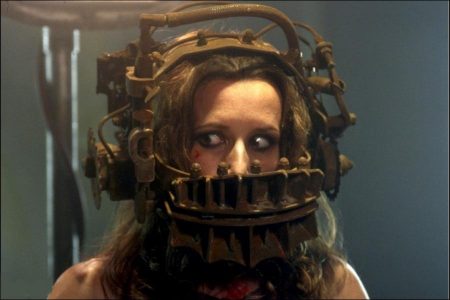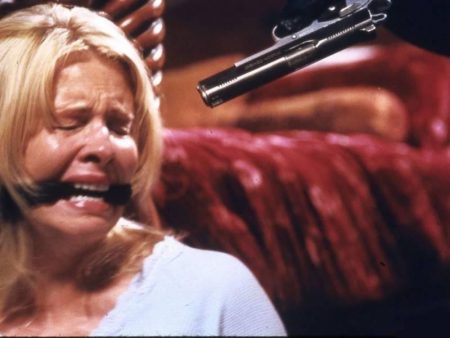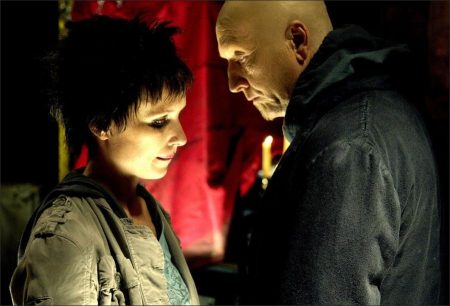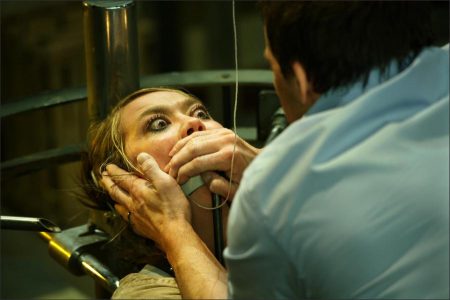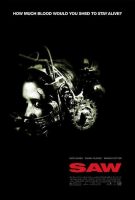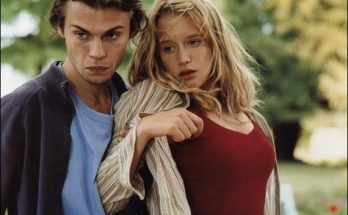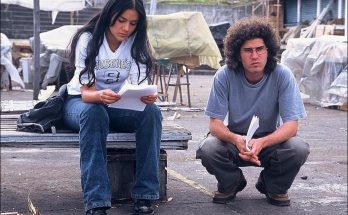From the very first frame of Lionbgate Films’ terrifying new horror film, Saw, the audience is thrown into the unknown: two men wake up in a subterranean bathroom, both chained to the wall. They know only that one man must kill the other within eight hours or both will die. An intense, complex thrill ride with a puzzle-like plot and a surprise ending that has earned screams from festival audiences, SAaw has a visceral, uniquely human perspective on horror.
“I think the film allows you to imagine yourself in the situation of these characters,” says cowriter/director James Wan. “It constantly asks, ‘If you were in their shoes, what would you do? Would you do the unthinkable to survive?’”
“It’s the ‘unknown’ factor,” adds co-writer / actor Leigh Whannell, who also stars in the film as Adam. “Not knowing where you are or what is going on, basically having no control, is terrifying. SAW is told from the victims’ point of view, rather than the police’s point of view, as we so often see in procedural thrillers. As the film progresses, the audience is piecing together the clues in real time along with the characters. It makes it very easy to identify with.”
Each victim in SAW is faced with a horrific choice upon which his or her life rests. A man must escape being buried alive by forcing himself through a web of flesh-cutting wires; a woman must kill another man to free herself from a steel head casing that is timed to tear off her jaw… It’s these games, masterminded by a killer known only as Jigsaw, which elevate SAW beyond traditional horror fare, lending a shocking sense of the macabre to the pervading atmosphere of terror.
“Jigsaw’s ingenuity is what really distinguishes this film,” says producer Oren Koules. “The games he forces his victims to play are horrifying and dark, but more importantly, they’re utterly original. Audiences haven’t seen anything like them.”
Whannell admits to trying to devise the most shocking murders possible. “I couldn’t have Jigsaw challenging his victims to an all-night game of Twister!” he says laughing. “The games he devised had to be pretty hardcore. So I found myself imagining all these sick little scenarios, as if I were a maniac myself.”
In another macabre spin on the genre, SAW also functions as a grim morality tale. Jigsaw is not driven solely by cruelty or insanity; he also wants to teach his morally deficient victims a lesson about the value of life. In one chilling scene, one of the survivors of Jigsaw’s games actually credits Jigsaw for helping change her life.
Danny Glover, who plays Detective Tapp, finds this to be one of the most interesting elements of SAW. “Even the antagonist, the guy who we most hate in this movie, is someone who philosophically has something to say about the way in which we respect life,” he says.
“Jigsaw makes his victims appreciate how precious life is by threatening to take it away,” says Cary Elwes, who plays Dr. Lawrence Gordon, one of Jigsaw’s unwitting captives. “He’s saying ‘Don’t take life for granted, and don’t wait until it’s too late.”
For Wan, SAW was the perfect opportunity to put a new spin on the traditional horror film. “For me, the horror genre is one genre that allows you to play outside the boundary of established conventions,” says the director. “I’ve always approached the project like a whodunit, a puzzle movie. I took a thriller storyline and told it in the style of a horror film.”
Producer Gregg Hoffman agrees: “If you’re going to do a genre film, I always think you have to twist it, shake it up, surprise people. Elevate it in some way. SAW would be a classic Hitchcock film if Hitchcock had watched too many Nine Inch Nails videos.”
Wan cites filmmakers like David Lynch and Dario Argento as the primary sources of inspiration for the gritty, surreal look of SAW. “I wanted to take real people and put them into an alien, Lynchian universe inhabited by the macabre freakishness of Argento,” he says. “From the outset I wanted SAW to be a vicious film of ferocious intensity where none of the characters or situations are safe.”
Wan and Whannell met in film school in Australia where Wan was already displaying an appreciation for unique genre fare. Whannell recalls, “We went to a really arty film school with lots of black nail polish and berets and guys making films about sand. James would get up and show his films, and they’d be about zombies. I knew he was going to become something big.”
Wan and Whannell set about writing a script together with a simple premise: two men are trapped in a bathroom; one man has to kill the other. From this compellingly simple scenario, a story grew and broadened, encompassing flashbacks and a host of other characters.
Once Whannell understood what the theme of the story was, he knew he could start writing. “I had some health problems before the writing of SAW, which while not life-threatening in the end, really shook me up and made me think about the way I was living life,” remembers Whannell. “It honestly changed me. I thought that would be an interesting theme to structure a thriller around.”
“The script was designed in such a way that all the separate strands would eventually come together in the end,” says Wan. “Like jigsaw puzzle pieces making up the whole picture.”
When they finished the script, Wan and Whannell were urged by their manager to fly to Los Angeles to take meetings on the project. However, for the two broke, would-be filmmakers, a trip all the way to North America seemed like “an expensive handshake.” Hoping to make the trip as productive as possible, they realized there was only one thing to do – spend more money.
Scraping together a few thousand dollars, the young filmmakers shot a brutally compelling scene from the script starring Whannell, hoping to use this short film to sell themselves as a capable director and star. They burned the film onto a DVD and submitted it to L.A. producers with their script. “It’s the smartest thing we’ve ever done,” states Whannell.
Several thousand miles away in Los Angeles, producer Gregg Hoffman was waiting for a meeting to start when an agent friend pulled him into an office and showed him Wan’s and Whannell’s DVD. “About two or three minutes into it, my jaw hit the floor,” says Hoffman. “I ran back to my office with the DVD and the script and showed it to my partners Oren Koules and Mark Burg.”
By the time Wan and Whannell had stepped off the plane onto Los Angeles soil, Hoffman, Koules, and Burg had already made an offer to finance the movie with Wan directing and Whannell starring in the role of Adam. Of the DVD Whannell simply says, “It was one of those few things in life that did exactly what it was meant to do.” Three months later, Wan and Whannell were shooting SAW.
On the basis of the DVD and the script, Wan and his producers found they were able to attract considerable star power to the project. When Cary Elwes watched the DVD, he sent Koules an e-mail with only one word: “Wow.” He sat down to read the script and found he couldn’t stop. “I read it in one sitting, which I never do,” says Elwes. “I thought, ‘Okay, I’ve got to do this. I’ve got to.’ It was just wonderful writing, an incredibly taut suspense thriller. ”
Monica Potter, who plays Dr. Gordon’s wife Alison, remembers watching the DVD for the first time. “I watched it, and then I had to watch it again. And it disturbed me because I wanted to do it. I wanted to be in this film and I was trying to figure out why. It got me a little worried.”
“James and Leigh have tapped into something, into the psyche,” adds Elwes. “I walked around the first couple of days on set and everyone was saying to me, ‘Isn’t this script amazing?’ You never hear crew members say that. Ever.”
For the role of Tapp, the police detective who becomes obsessed with stopping Jigsaw, Wan set his sights on Danny Glover. Glover was “really impressed with Wan’s vision,” and signed on immediately, attracted to the multi-dimensional role. Glover smiles as he recalls how Wan came to choose him for the role. “James saw me in an infomercial in Australia,” he says, laughing. “He wasn’t saying, ‘I saw you in another film.’ He saw me in an infomercial.”
Since the relationship between Dr. Gordon and Adam forms the core of SAW, Elwes felt it was imperative that he and Leigh Whannell have rehearsals before production began. “These two characters bond in this room in a very strange way,” says the actor. “They go through all kinds of emotions with each other, but in the end, they really have found some common thread, even when they end up being antagonistic. We found some wonderful things in rehearsal. We were very lucky.”
Says Whannell: “The biggest challenge for me was to try and hold my own opposite a great actor like Cary. Luckily, he was such a great and gracious guy that I got over my nerves pretty quickly. ”
Having already proven his acting skills in the short film he and Wan made, Whannell packed away his “writer’s hat” and threw himself into his first starring role in a feature film. However, watching his vision come to life proved to be more than a little surreal. “When something’s in your head for so long, to be able to touch it is really amazing,” says the young actor/writer. “Like that bathroom, the main set. It was in my head for two years, and then all of a sudden I could walk into it. I could touch the walls. That was incredible.”
Whannell could often be seen on set with headphones on, listening to music before shooting a scene. “Sometimes it’s difficult to muster up that primal level of anger or fear, especially when you’re achieving your dream of making a film. I found music would take me to a particular emotional place in a short amount of time.”
Whatever his methods, it’s clear that Whannell more than holds his own opposite his seasoned co-stars. “Leigh is a really talented guy,” says Elwes. “I’m very excited for him because he’s going to take off after this movie.”
The cast was equally excited by first-time director James Wan, who proved that directing is, in Elwes’ words, “a job he was born to do.” For Wan, shooting SAW far surpassed his expectations. “I always thought that my first film would be with a couple of my mates back home, a couple of friends getting together sitting around a table,” he says. “But this is amazing. It’s been especially great working with the cast and crew. Everyone’s been so supportive of me. I’ve been very fortunate.”
“I think that James is going to be one of the most promising new directors to arrive on the scene. No question,” asserts Elwes. “He’s such a visionary, and he’s so wonderful with actors. He creates an environment where you feel so comfortable that you feel like you can try anything.”
“He gives you the space to be creative,” adds Glover. “It’s truly a collaborative effort.”
Monica Potter believes that James’ relative inexperience was actually an asset, as it allowed him to be more responsive and flexible as a director. “Older directors can be stubborn,” says the actress. “James is aggressive and very helpful. He knows exactly what he wants, but he loves new ideas, too. He’s awesome.”
Audiences have clearly responded to SAW’s masterful performances and taut suspense, but it’s the film’s shocking surprise ending that has really sparked conversation. “The twist at the end is definitely what makes the movie,” says producer Mark Burg, “and we’re not giving it away.”
“My hope is that the ending makes people walk out thinking about the entire movie, the way it did with films like The Usual Suspects and The Sixth Sense,” says Whannell. “With those films, you cast your mind back to earlier scenes and things become clearer. The whole film has resonance.”
Wan relishes the effect of the final frames on his audience. “I want people to walk out shattered. Completely and utterly shattered,” he says, laughing. “That’s the plan.”
Saw (2004)
Directed by: James Wan
Starring: Cary Elwes, Danny Glover, Leigh Whannell, Monica Potter, Michael Emerson, Dina Meyer, Shawnee Smith, Makenzie Vega, Paul Gutrecht, Alexandra Bokyun Chun
Screenplay by: Leigh Whannell
Production Design by: Julie Berghoff
Cinematography by: David A. Armstrong
Film Editing by: Kevin Greutert
Costume Design by: Jennifer L. Soulages
Art Direction by: Nanet Harty
Music by: Charlie Clouser
MPAA Rating: R for strong grisly violence and language.
Distributed by: Lionsgate Films
Release Date: October 29, 2004
Views: 179
